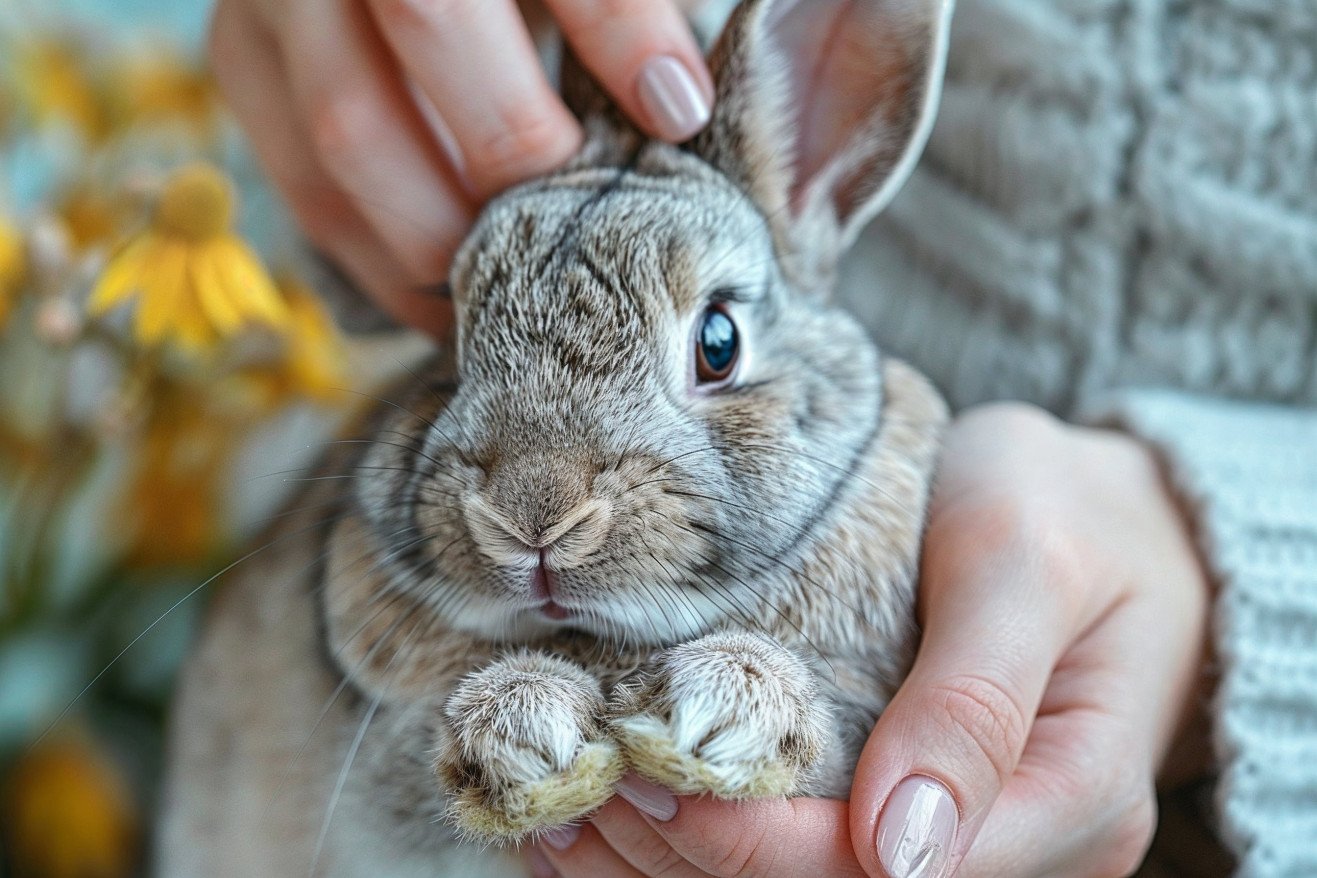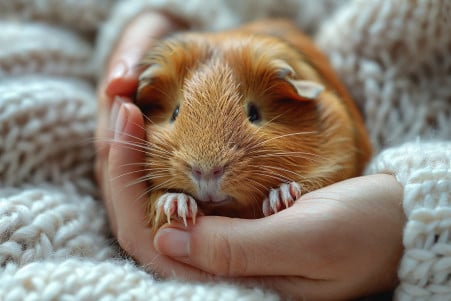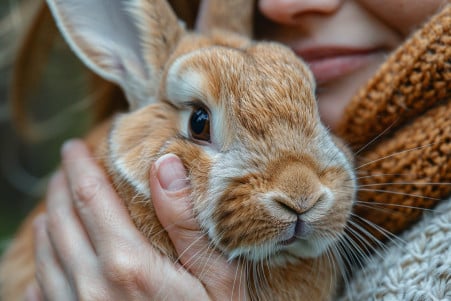How to Clip Rabbit Nails: A Step-By-Step Guide
14 April 2024 • Updated 14 April 2024

Rabbits make wonderful pets, but one of the most challenging aspects of rabbit care is learning how to clip your rabbit's nails. Rabbit nails should be clipped every 4-6 weeks using pet nail clippers, and it's important to avoid cutting the quick (the blood vessel inside the nail). Gently hold your rabbit in place, possibly with the help of a friend. Clip the tips of the overgrown nails at a 45-degree angle as quickly as possible. Give your rabbit treats and a place to hide afterward, as nail clipping can be stressful for rabbits.
In this article, we'll go over the techniques that veterinarians recommend for clipping your rabbit's nails at home. This includes the tools you'll need and how to safely hold your rabbit, as well as how to make the process less stressful and what to do if you accidentally cut the quick. With our help, you can make nail clipping a regular and stress-free part of your and your beloved rabbit's routine.
How can you clip your rabbit's nails without causing them stress?
How to Tell If Your Rabbit's Nails Are Too Long
As a rabbit owner, it's important to make sure you're keeping an eye on your pet's nails and clipping them when necessary. The Rabbit Welfare Association & Fund notes that overgrown nails can cause issues like snagging, pain, and an unnatural foot angle that puts extra strain on the joints. Meanwhile, the Rabbit Welfare Association & Fund explains that long nails can also increase the chances of the nails being torn or ripped out, which can be painful and cause bleeding. In the worst-case scenario, this can even lead to dislocation or fractures of the toes.
In addition, unclipped nails can cause the rabbit's weight to be pushed back onto their heels, which can lead to sore hocks (pododermatitis) - a painful and challenging condition to treat. In general, the Rabbit Welfare Association & Fund recommends that you clip your rabbit's nails when they extend past the surrounding fur, which can happen every 3-12 weeks. However, it's best to keep an eye on your rabbit's nails and schedule clippings as needed.
If your rabbit's nails are extremely long, you can gradually clip them back by "nibbling" off small pieces every few days. This will help the quick (blood vessel in the nail) recede, which will make it possible to clip the nails to a safe length over time, according to the Rabbit Welfare Association. Regular nail clippings are important for your rabbit's comfort, movement, and overall health.
How to Trim Rabbit Nails: A Step-by-Step Guide
The first step in trimming your rabbit's nails, according to the step-by-step guide on The Spruce Pets, is to make sure you have everything you need. This includes a good pair of cat or rabbit nail clippers, like the Kaytee Pro Nail Trimmer, a towel, styptic powder, and some treats to reward your rabbit.
The Bunny Lady guide also suggests having a helper to safely hold the rabbit while you do the trimming. The person holding the rabbit should hold the rabbit in a way that exposes all of their paws, while the person doing the trimming can access all of the nails. If you don't have a helper, you can put your rabbit on a table with a towel and wrap your arm around them to gently pull out each paw.
When you're trimming the nails, it's important to know where the quick is, which is the vein that runs up the center of each nail. As the Park Gate Animal Hospital points out, cutting the quick will hurt your rabbit and cause bleeding. You should only cut the tip of the nail, which is curved, and you should cut it at a slight angle, making sure to stop before you get to the quick. If you accidentally cut the quick, you should quickly apply styptic powder or cornstarch to stop the bleeding.
How to Make the Experience Less Stressful and Uncomfortable for Your Rabbit
Nail trimming can be a stressful experience for both rabbit and owner. As Archie's Angels RR notes, rabbits will often kick and struggle as you try to keep them calm during the nail trimming process. To help minimize this stress, it's important to work slowly and positively.
The Howcast guide suggests starting by getting your rabbit used to being restrained. Sit with your rabbit and pet them until they are calm and relaxed before attempting to trim their nails. If your rabbit is still anxious, the Home & Roost guide recommends using a towel to wrap and restrain your rabbit, which can help them feel more secure and keep them in place.
Make sure to use positive reinforcement. Give your rabbit their favorite treats during and after the nail trimming to make the experience more positive. The Archie's Angels RR guide also suggests taking breaks if your rabbit gets too stressed and then trying again later that day or the next. With time and patience, and by working slowly and positively, you can help your rabbit get used to nail trims.
When to Get Professional Help With Nail Trimming
While trimming your rabbit's nails at home is certainly doable, there are some instances in which it's best to get professional help. Per the wikiHow guide, if your rabbit is very skittish or hard to hold down, it's best to have a vet trim their nails to avoid potential injury. Rabbits that "wriggle and squirm" are more likely to get hurt if the person trimming their nails is inexperienced.
The Vets4Pets guide notes that rabbits can get very stressed if they're not handled properly during grooming, including nail trimming. In fact, if a rabbit is held incorrectly and kicks, it can kick so hard that it breaks its own back, according to the Belle Mead Animal Hospital. For the safety of your rabbit, it's best to have a trained veterinary technician or groomer trim your rabbit's nails if you're not confident or if your rabbit is especially hard to handle.
If you're taking your rabbit to the vet to have their nails trimmed, the Belle Mead Animal Hospital suggests using a secure cat carrier to transport them. This will help ensure that your rabbit stays calm and contained during the trip. The advantages of having a professional trim your rabbit's nails include their experience handling rabbits and their ability to trim the nails quickly and safely.
Keeping Your Rabbit's Nails Healthy
Keeping your rabbit's nails healthy between trims is important for their overall well-being. According to the Bunny Lady guide, one way to help your rabbit maintain healthy nail length is to make sure they have access to surfaces that allow them to dig and scratch. This can include cardboard boxes, wooden blocks, or even a digging box that you can fill with hay or other safe materials.
As the Best Friends Animal Society explains, it's important to make sure your rabbit's living space is enriched in a way that encourages natural nail wear. Since rabbits are natural diggers, giving them plenty of opportunities to dig can help ensure that their nails don't get too long. In addition to this, a healthy diet and exercise are also important factors in maintaining your rabbit's nail health, according to the BinkyBunny forum.
In addition to these factors, it's important to make sure that you're keeping an eye on your rabbit's nails and scheduling regular trims to make sure that they don't get too long between professional trims. While you can help your rabbit maintain healthy nails by providing an enriched environment and encouraging natural behaviors, make sure that you're still checking their nails at least once a month and scheduling trims as needed to avoid any problems.
Conclusion: How to Make Sure Your Rabbit Stays Happy and Healthy
While dealing with a broken or bleeding rabbit nail can be scary, it's important to remember that you can help your rabbit feel better by keeping a cool head and following the proper steps. If your rabbit's nail is bleeding, the first thing you should do is apply pressure to the toe with a clean cloth or cotton swab. Keep pressure on the area for at least 60 seconds to help stop the bleeding.
If the bleeding continues, you can use cornstarch, flour, or styptic powder to help stop the bleeding. Apply the powder directly to the nail, and then apply pressure to the area with a cloth or cotton swab for 30-60 seconds. The Bunny Lady suggests using cornstarch, as it's safer for your rabbit to ingest if they lick the area after you've treated it.
If you've accidentally cut your rabbit's nail too short and caused it to bleed, you can clean the area with a cotton ball soaked in Bactine and apply Neosporin to help prevent infection. However, as the Rabbits Online forum points out, you should be careful when using these products, as your rabbit may lick the area.
No matter what caused the issue, make sure to keep a close eye on your rabbit's nail to ensure that it's no longer bleeding and that it doesn't become infected. With the right first aid and a little bit of time, your rabbit's nail should heal in no time, and they'll be back to their happy, healthy self.


